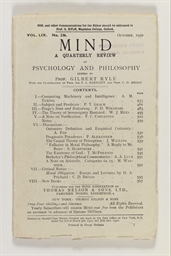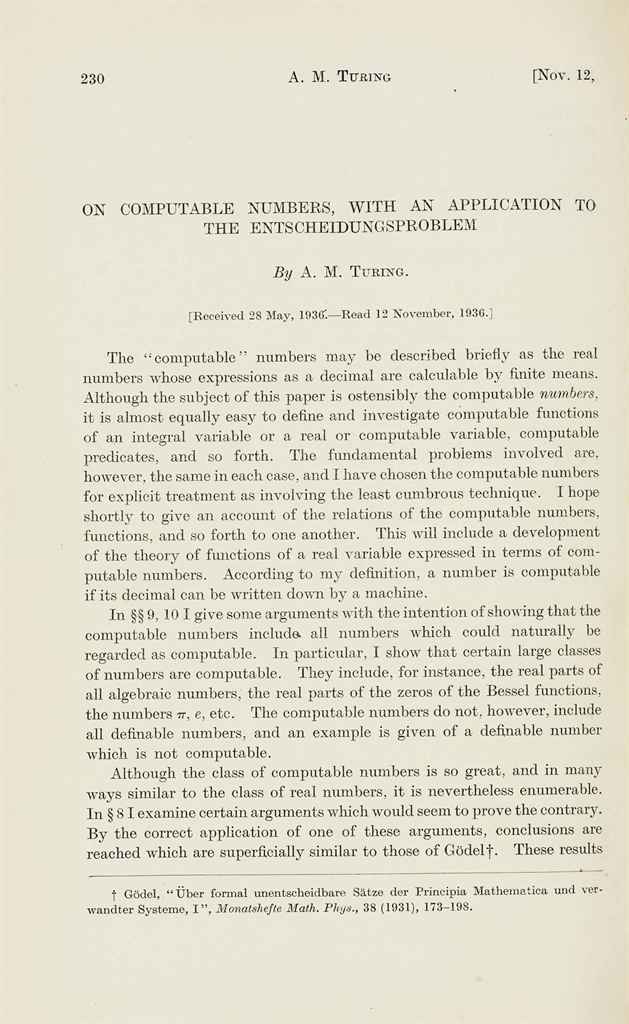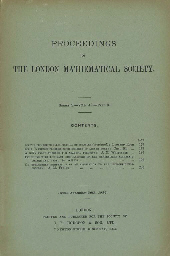TURING, Alan Mathison. "Computing machinery and intelligence." In Mind 59 (1950): 433-60. 8 o. Original gray printed wrappers; boxed. FIRST EDITION. To answer the question of whether or not electronic computers think, Turing proposed an experiment, later called the Turing test, that would allow the unbiased comparison of a machine's "thinking behavior" with that of a normal human being. The test involves two parties, "X" and "Y", who engage in a conversation by teletype. Human X cannot know whether Y is a machine or a person. If X believes that Y is responding like a person after a specified period of time, and Y turns out to be a machine, then that machine may be defined as having the capacity to "think." From the time he wrote his paper on computable numbers in which he modeled his "Turing" machines after the way people carry out computations, Turing believed that every human thought that could be expressed in language could be mimicked by a universal machine, or computer, if it was suitably programmed. Concerning the future of artificial intelligence, Turing wrote in this paper published in 1950, "I believe that in about fifty years' time it will be possible to programme computers with a storage capacity of about 109, to make them play the imitation game so well that an average interrogator will not have more than 70 per cent chance of making the right identification after five minutes of questioning. The original question, 'Can machines think?' I believe to be too meaningless to deserve discussion. Nevertheless I believe that at the end of the century the use of words and general educated opinion will have altered so much that one will be able to speak of machines thinking without expecting to be contradicted" (p. 442). "Turing's work at Manchester [from 1948 onward] was among the earliest investigations of the use of electronic computers for artificial-intelligence research. He was among the first to believe that electronic machines were capable of doing not only numerical computations, but also general-purpose information processing. He was convinced computers would soon have the capacity to carry out any mental activity of which the human mind is capable. He attempted to break down the distinctions between human and machine intelligence and to provide a single standard of intelligence, in terms of mental behavior, upon which both machines and biological organisms could be judged. In providing his standard, he considered only the information that entered and exited the automata. Like Shannon and Wiener, Turing was moving toward a unified theory of information and information processing applicable to both the machine and the biological worlds ..." (Aspray , Scientific Conceptualization of Information , 1985, 132). From Gutenberg to the Internet 11.2. OOC 936. [ With: ] TURING. "Some calculations of the Riemann zeta-function." In Proceedings of the London Mathematical Society , third series, 3 (1953): 99-117. Whole number. Original green printed wrappers. OOC 938. -- TURING. "Solvable and unsolvable problems." In Science News 31 (1954): 7-23. Whole number. Original red printed wrappers. OOC 939. -- [TURING.] WOODGER, Michael. The history and present use of digital computers at the National Physical Laboratory . Offprint from Process Control and Automation (November 1958). Unbound; tipped into later plain white wrappers. OOC 940. -- TURING. A. M. Turing's ACE report of 1946 and other papers . Edited by B. E. Carpenter and R. W. Doran. Cambridge: MIT Press; Los Angeles: Tomash Publishers, 1986. OOC 941. -- DAVIS, Martin. Computability and unsolvability . New York: McGraw-Hill, 1958. Original red cloth, printed dust-jacket. OCC 563 -- TURING. "Checking a large routine." In Report of a conference on high speed calculating-machines, 22-25 June 1949 (Cambridge: University Mathematical Laboratory, 1950), pp. 67-68. OOC 935.
TURING, Alan Mathison. "Computing machinery and intelligence." In Mind 59 (1950): 433-60. 8 o. Original gray printed wrappers; boxed. FIRST EDITION. To answer the question of whether or not electronic computers think, Turing proposed an experiment, later called the Turing test, that would allow the unbiased comparison of a machine's "thinking behavior" with that of a normal human being. The test involves two parties, "X" and "Y", who engage in a conversation by teletype. Human X cannot know whether Y is a machine or a person. If X believes that Y is responding like a person after a specified period of time, and Y turns out to be a machine, then that machine may be defined as having the capacity to "think." From the time he wrote his paper on computable numbers in which he modeled his "Turing" machines after the way people carry out computations, Turing believed that every human thought that could be expressed in language could be mimicked by a universal machine, or computer, if it was suitably programmed. Concerning the future of artificial intelligence, Turing wrote in this paper published in 1950, "I believe that in about fifty years' time it will be possible to programme computers with a storage capacity of about 109, to make them play the imitation game so well that an average interrogator will not have more than 70 per cent chance of making the right identification after five minutes of questioning. The original question, 'Can machines think?' I believe to be too meaningless to deserve discussion. Nevertheless I believe that at the end of the century the use of words and general educated opinion will have altered so much that one will be able to speak of machines thinking without expecting to be contradicted" (p. 442). "Turing's work at Manchester [from 1948 onward] was among the earliest investigations of the use of electronic computers for artificial-intelligence research. He was among the first to believe that electronic machines were capable of doing not only numerical computations, but also general-purpose information processing. He was convinced computers would soon have the capacity to carry out any mental activity of which the human mind is capable. He attempted to break down the distinctions between human and machine intelligence and to provide a single standard of intelligence, in terms of mental behavior, upon which both machines and biological organisms could be judged. In providing his standard, he considered only the information that entered and exited the automata. Like Shannon and Wiener, Turing was moving toward a unified theory of information and information processing applicable to both the machine and the biological worlds ..." (Aspray , Scientific Conceptualization of Information , 1985, 132). From Gutenberg to the Internet 11.2. OOC 936. [ With: ] TURING. "Some calculations of the Riemann zeta-function." In Proceedings of the London Mathematical Society , third series, 3 (1953): 99-117. Whole number. Original green printed wrappers. OOC 938. -- TURING. "Solvable and unsolvable problems." In Science News 31 (1954): 7-23. Whole number. Original red printed wrappers. OOC 939. -- [TURING.] WOODGER, Michael. The history and present use of digital computers at the National Physical Laboratory . Offprint from Process Control and Automation (November 1958). Unbound; tipped into later plain white wrappers. OOC 940. -- TURING. A. M. Turing's ACE report of 1946 and other papers . Edited by B. E. Carpenter and R. W. Doran. Cambridge: MIT Press; Los Angeles: Tomash Publishers, 1986. OOC 941. -- DAVIS, Martin. Computability and unsolvability . New York: McGraw-Hill, 1958. Original red cloth, printed dust-jacket. OCC 563 -- TURING. "Checking a large routine." In Report of a conference on high speed calculating-machines, 22-25 June 1949 (Cambridge: University Mathematical Laboratory, 1950), pp. 67-68. OOC 935.





.jpg)

.jpg?height=400)

Try LotSearch and its premium features for 7 days - without any costs!
Be notified automatically about new items in upcoming auctions.
Create an alert